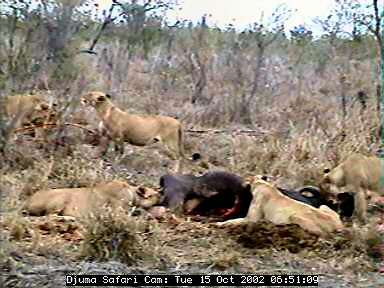| Name: African lion |
| Scientific name: Panthera leo |
| Range: Central Africa |
| Habitat: Open and lightly wooded grassland |
| Status: Not threatened |
| Diet in the wild: zebra, buffalo, giraffe, warthogs |
| Diet in the zoo: carnivore diet |
| Location: Overlooking the African Hoof Stock Exhibits |
| Physical description:
Length 7.9 to 9.5 feet, weight 265 to 420 lbs. The coat pattern for adults is tawny yellow. The cubs' coat is wooly with dark spots against a lighter background. Males have a large mane and are about 50% larger than females. The color of the mane in males varies from yellow to black. |
| Special anatomical, physiological or behavioral adaptations:
Territories are scented marked with urine, feces, and head rubbing. Lions mark with their claws on trees and other signposts. The mane of the male provides protection from the claws and teeth of other males. . They eat anything they can catch and kill, and groups have even been observed killing rhinoceros. A lion can eat up to 35 grams of meat at a sitting. They drink freely when water is available, but they can survive only on the water they get from their prey for long periods of time. Lions can run at speeds over 30 mph, but only over short distances. This speed is insufficient for catching a large antelope, so group stalking is an important hunting strategy. Lions appear to assess how much effort will be required for taking down a particular target, and if the prey is small enough to be taken by a single female, the other members of the hunting group will let her catch it alone. |
| Personal Observations:
Some adult lions, like the females at the Fort Worth Zoo, retain some of their baby spots. The lions are housed just opposite the African hoofed stock and these two are watching the kudu with great interest. |
| Related Links:
Lion kill => |
 |
 |
| Page author: Veronica Donald
donaldveronica@hotmail.com |
| Source list: Birmingham
Zoo: http://www.birminghamzoo.com/animals/lion.html
|